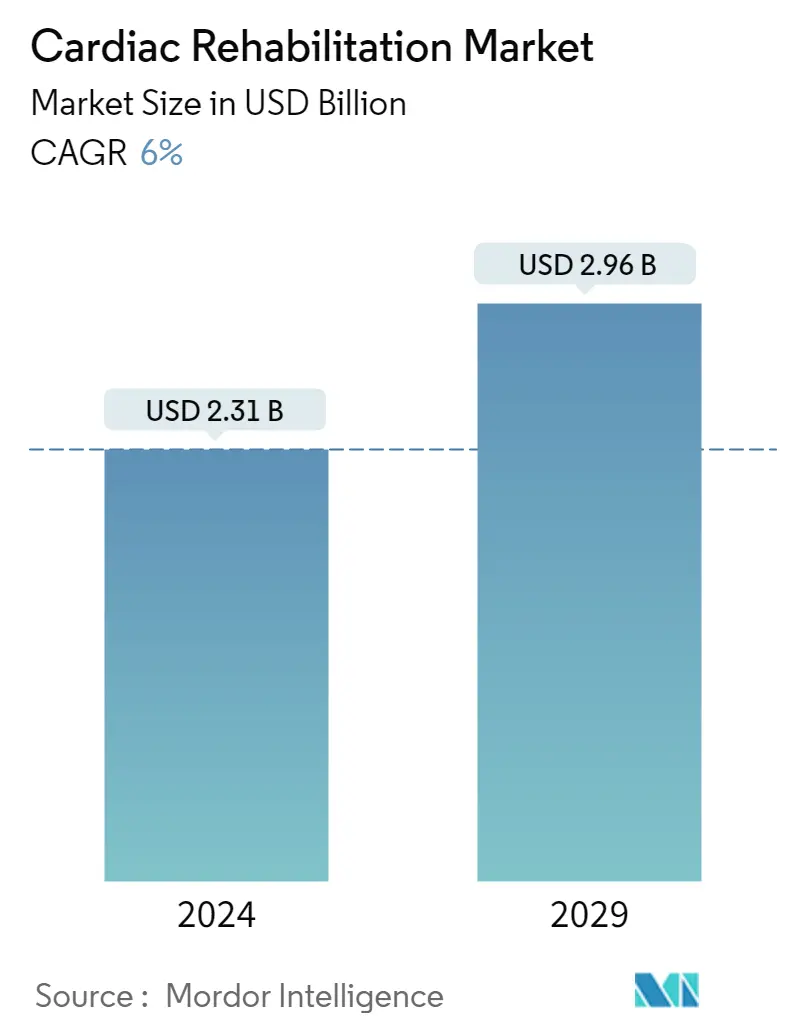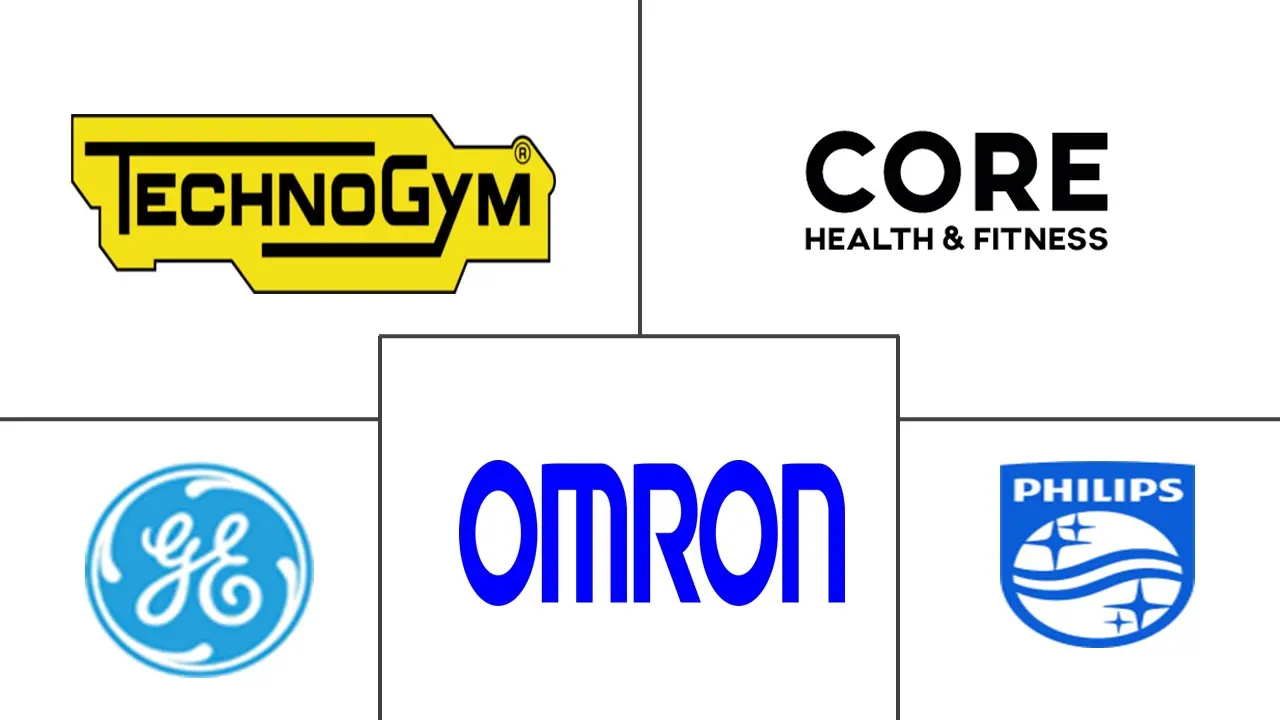Market Size of Cardiac Rehabilitation Industry

| Study Period | 2019 - 2029 |
| Market Size (2024) | USD 2.31 Billion |
| Market Size (2029) | USD 2.96 Billion |
| CAGR (2024 - 2029) | 6.00 % |
| Fastest Growing Market | Asia-Pacific |
| Largest Market | North America |
| Market Concentration | Medium |
Major Players
*Disclaimer: Major Players sorted in no particular order |
Cardiac Rehabilitation Market Analysis
The Cardiac Rehabilitation Market size is estimated at USD 2.31 billion in 2024, and is expected to reach USD 2.96 billion by 2029, growing at a CAGR of 6% during the forecast period (2024-2029).
The specific characteristics of the COVID-19 pandemic made it challenging to identify whether and how people with heart disease could participate safely in cardiac rehabilitation and center-based exercise programs. According to the study published by the European Journal of Preventive Cardiology in August 2022, the pandemic had increased the demand for rehabilitation for COVID-19 patient groups who were critically ill with COVID-19 disease. Additionally, remote patient monitoring using implantable cardiac rehabilitation products was a safe alternative to in-person-only visits, which led to enhanced patient satisfaction and improved clinical outcomes. For instance, in February 2021, RhythMedix launched the next-generation cardiac monitor RhythmStar with built-in 4G cellular connectivity for arrhythmia detection. Therefore, there had been a greater need for cardiac rehabilitation, which was anticipated to have a beneficial impact on the market due to the COVID-19 pandemic. However, the market is returning to its pre-pandemic state due to decreased COVID-19 cases and the recovery of the healthcare sector with enhanced health access. The market will continue to rise steadily over the forecast period.
The cardiac rehabilitation market is primarily driven by increasing efforts to reduce heart diseases across the globe and the rising focus of the general population on health and fitness in developed countries. For instance, an article published by WHO in September 2022 called for a united effort to reduce mortality from cardiovascular diseases, a leading cause of death in the Southeast Asia Region, with 3.6 million lives lost every year. Through SEA HEARTS, the "WHO Southeast Asia HEARTS initiative," the WHO Southeast Asia Region intends to scale up and integrate ongoing activities in order to reduce mortality from cardiovascular diseases (CVDs) by one-third by 2030.
Additionally, according to the above source, representatives from Member countries, partners, academic institutions, and civil society organizations took part in the SEA HEARTS webinar, which examined strategies to speed up action against CVDs as part of a coordinated effort to promote cardiovascular health. Thus, such efforts are expected to reduce heart disease, leading to an increased demand for cardiac rehabilitation.
Furthermore, due to the demand for cardiac rehabilitation, market players are also focusing on product development and novel launches. For instance, in March 2022, MFine launched a Heart Rate Monitoring (HR) Tool on its app, which enables users to keep track of their heart rate without needing an additional device or any other app. Hence, as per the factors mentioned above, the cardiac rehabilitation market is anticipated to grow over the forecast period. However, a lack of knowledge in developing or underdeveloped nations is expected to impede market growth over the forecast period.
Cardiac Rehabilitation Industry Segmentation
Cardiac rehabilitation includes supervision of the heart condition with medical aid, including proper exercises and doctor-recommended medical devices. Cardiac rehabilitation is the procedure that is carried out after getting treatment for certain conditions such as heart attack or failure, heart surgery, or bypass grafting.
The cardiac rehabilitation market is segmented by product type (treadmill, elliptical trainer, stabilization ball, rower, blood pressure monitor, heart rate monitor, and other product types) and geography (North America, Europe, Asia-Pacific, Middle East, and Africa, and South America). The market report also covers the estimated market sizes and trends for 17 different countries across major regions globally.
The report offers the value (in USD) for the above segments.
| By Product Type | |
| Treadmill | |
| Elliptical Trainer | |
| Stabilization Ball | |
| Rower | |
| Blood Pressure Monitor | |
| Heart Rate Monitor | |
| Other Product Types |
| Geography | ||||||||
| ||||||||
| ||||||||
| ||||||||
| ||||||||
|
Cardiac Rehabilitation Market Size Summary
The cardiac rehabilitation market is poised for steady growth over the forecast period, driven by increasing global efforts to combat heart diseases and a heightened focus on health and fitness, particularly in developed regions. The market's expansion is supported by initiatives such as the WHO's SEA HEARTS program, which aims to reduce cardiovascular disease mortality in Southeast Asia. The COVID-19 pandemic initially boosted demand for cardiac rehabilitation, as remote monitoring and innovative products like RhythMedix's RhythmStar enhanced patient care. However, as the healthcare sector recovers and COVID-19 cases decline, the market is stabilizing. The introduction of novel products and technologies, such as MFine's Heart Rate Monitoring Tool and Peloton's treadmill with safety features, further propels market growth, despite challenges in knowledge dissemination in developing regions.
North America leads the cardiac rehabilitation market, benefiting from advanced healthcare infrastructure and initiatives like the Million Hearts program, which aims to significantly reduce heart disease and stroke incidents. The Canadian government's investment in programs to enhance physical activity among seniors and low-income communities also contributes to market growth. The market is moderately concentrated, with key players like GE Healthcare and Koninklijke Philips N.V. actively engaging in strategies such as mergers, acquisitions, and product launches to strengthen their market positions. The introduction of innovative products, such as SupeRun's 2-in-1 Folding Treadmill and Johnson Health Tech's smart home treadmill, underscores the ongoing commitment to advancing cardiac rehabilitation solutions.
Cardiac Rehabilitation Market Size - Table of Contents
-
1. MARKET DYNAMICS
-
1.1 Market Overview
-
1.2 Market Drivers
-
1.2.1 Increasing Efforts to Reduce the Heart Diseases Across the Globe
-
1.2.2 Rising Focus of General Population on Health and Fitness in Developed Countries
-
-
1.3 Market Restraints
-
1.3.1 Lack of Knowledge in the Developing or Under Developed Nations
-
-
1.4 Porter's Five Forces Analysis
-
1.4.1 Threat of New Entrants
-
1.4.2 Bargaining Power of Buyers/Consumers
-
1.4.3 Bargaining Power of Suppliers
-
1.4.4 Threat of Substitute Products
-
1.4.5 Intensity of Competitive Rivalry
-
-
-
2. MARKET SEGMENTATION (Market Size by Value USD)
-
2.1 By Product Type
-
2.1.1 Treadmill
-
2.1.2 Elliptical Trainer
-
2.1.3 Stabilization Ball
-
2.1.4 Rower
-
2.1.5 Blood Pressure Monitor
-
2.1.6 Heart Rate Monitor
-
2.1.7 Other Product Types
-
-
2.2 Geography
-
2.2.1 North America
-
2.2.1.1 United States
-
2.2.1.2 Canada
-
2.2.1.3 Mexico
-
-
2.2.2 Europe
-
2.2.2.1 Germany
-
2.2.2.2 United Kingdom
-
2.2.2.3 France
-
2.2.2.4 Italy
-
2.2.2.5 Spain
-
2.2.2.6 Rest of Europe
-
-
2.2.3 Asia-Pacific
-
2.2.3.1 China
-
2.2.3.2 Japan
-
2.2.3.3 India
-
2.2.3.4 Australia
-
2.2.3.5 South Korea
-
2.2.3.6 Rest of Asia-Pacific
-
-
2.2.4 Middle East and Africa
-
2.2.4.1 GCC
-
2.2.4.2 South Africa
-
2.2.4.3 Rest of Middle East and Africa
-
-
2.2.5 South America
-
2.2.5.1 Brazil
-
2.2.5.2 Argentina
-
2.2.5.3 Rest of South America
-
-
-
Cardiac Rehabilitation Market Size FAQs
How big is the Cardiac Rehabilitation Market?
The Cardiac Rehabilitation Market size is expected to reach USD 2.31 billion in 2024 and grow at a CAGR of 6% to reach USD 2.96 billion by 2029.
What is the current Cardiac Rehabilitation Market size?
In 2024, the Cardiac Rehabilitation Market size is expected to reach USD 2.31 billion.

